#gay steelworkers
Text

365 Days of Drawing: Year 9
Day 337- Jun 1st, 2024
© Ethan H Hutchinson
HAPPY PRIDE MONTH!!! 🌈
#pencil#graphite#iykyk#mustache#Roscoe#steelworkers of America#keep reaching for that rainbow#gay steelworkers#the Simpson#we work hard we play hard#the anvil#pride#Pride month
3 notes
·
View notes
Text
i’m more of an actress!kara kind of gal, but i really like that current kara is working as a teacher in steelworks. plus, she is working with nat and they are like, one of my favourite ships for kara. i wish dc would give the girls an ongoing together.
#supergirl#kara zor el#natasha irons#steelworks#otho and osul have their gay aunts as teachers#who probably take them for pizza and ice cream every friday after school
3 notes
·
View notes
Text
ngl if nia ends up being why jon's able to finish breaking out of his brainiac/waller conditioning, and jon ends up vouching for her, i want jay to dump his ass. why? bc we know jon still loves him fiercely, and i wanna see his gay ass suffer lmao. if he was in love with jay's values as much as he was in love with his personality, i wanna know if jon's love can persevere knowing his beloved isn't willing to be a cookie cutter corporate employee at steelworks anymore. his mama's DEAD, jon, your own mother left you with your abusive grandpa cuz she couldn't handle being othered, but now you're caping for the girl who killed your boo's mom??? i want jay to spit on his face after rejecting him, bengali style. and i def wanna see if jon takes that shit lying down 😂
21 notes
·
View notes
Text
My big generalized no-thinking-needed litmus test for ships is this:
If you swapped the younger one to be a girl instead of a boy, would people call it predatory? If yes: then the younger one is too young.
For example:
Karen and Billy? Pushing 40, and barely 18. Make Karen a man and Billy a girl. Boom. Predatory. Karen being a "MILF" and Billy being a player doesn't make it not predatory, especially since they started flirting when Billy was 17. That would be seen as predatory were their genders swapped.
Karen is canonically an ephebophile. Their hookup plans being immediately followed by the intro to Billy's rape scene in Brimborn Steelworks is no accident. It's a commentary.
Karen, had she chosen to go ahead with the hookup (which she only aborted because she remembered "oh yeah, this would destroy my family", mind you), would have been 3 months outside the range for catching a statutory rape charge. Billy's birthday is March 30th, all that happened around July 3rd or so. 3 months outside the range for statutory rape.
Ephebophile:
An adult with sexual interest in teenagers, ages 15-19
[Murray voice] That, my friends, is predatory behavior. It's only seen as "cool" because Billy is a boy instead of a girl, and statutory rape of boys is glorified in society as some kind of rite of passage/"bagging a MILF". Thus, having their hookup prep lead directly into a rape scene is a message that Hey, this isn't actually as okay as you've been conditioned to believe it is.
So lets extend this to, say...Hopper and Steve. 40 something, and 18 going on 19. That's a Karen-Billy situation right there. Remember what I just said about Karen and Billy? Being gay does not exempt it from that classification.
And of course, swapping it to be an adult man pursuing a fresh-out-of-school 19 year old girl? Bam. Predatory without batting an eyelash over its classification as such.
So on and so forth with other ships.
#me talking about boys' upbringing being centered around making their own victim status a status symbol:#humans impose a structure of their own. a deeply unnatural structure.#imagine that one bts still of henward in the NINA tunnels standing there staring at you all insane-like#that's how i look while writing this post#(yes i'm aware of the irony here)
55 notes
·
View notes
Text


Steel closets : voices of gay, lesbian, and transgender steelworker by Anne Belay, available on the Internet Archive
Transcript:
Though Jay, possibly even further isolated as a gay man, has often worked in group settings, and describes the constant homophobic banter and jokes that then filled his days, he now works alone up in a pulpit. Still, he's a personable guy, and people drop by to pass the time, and "it's usually about really nonsense stuff, but like they'll make faggot gestures, tell faggot jokes, talk about getting their dicks sucked, and bend over. This one black guy teases me all the time about being gay for a joke, and I say, 'Come on, once you have black you never go back.' There are guys out there I totally fantasize about like crazy. But they're the type of guys they're so straight, they're liter- ally homophobic." Here, conversation isn't about sharing experiences, as in Erin's story, but about power plays and teasing. Jay says it's nonstop, constant insults. "And they'll say, 'Hey come on, why don't you give me a blow job, why don't you come suck my dick, bitch.' And I'm like, 'Drop your pants, let's go,' and they're like, 'Fuck you.' Or they say, 'Bend over, I'll give you what I've got,' and I'm like, 'OK, come over, I'm ready.' I go, 'You know me, I'd love to get you some place, take your pants down, and we'll go to town.' And they think I'm joking. I haven't lied to them one time, you know the thing of it is, if they ever, ever, ever find out I'm gay, I've always said I was, they just don't believe me. And this is all the time." Jay admits to being gay ironically-with an exaggeration that insists otherwise-and he's terrified ("ever, ever, ever") that his actual, lived gayness might someday be revealed. Queer workers deploy individual strategies to remove their real thoughts, their real self, from their interactions at work. Day after day, year after year, this becomes both dehumanizing and exhausting.
End transcript.
25 notes
·
View notes
Note
What are the Pinkertons?
Pinkerton is a group that sells itself as private security and a detective agency. What they're known for are being union busters. Businesses hire them to infiltrate unions, keep an eye on anyone who might be pushing unionization, and intimidate strikers and unions.
During the Homestead Strike back in 1892 their involved lead to the deaths of 9 Steelworkers when they fired into a crowd. They were also involved with the 1877 Railroad Strike and the Battle of Blair Mountain.
Their involvement led to the downfall of the Molly Maguires, a group of activist with the Irish American and Irish immigrant coal miners. The Pinkertons gave information on people suspected of being in the organization to people with grudges against them so the miners would be ambushed and murdered.
The Compton Cafeteria riot is one of the first LGBT riots, predating Stonewall by 3 years. It hired Pinkertons in 1966 toharass gay and trans customers.
They've long been suspected of having been deeply involved with the Haymarket massacre which resulted in seven anarchist arrested despite no evidence ever presented linking them to the crime. It resulted in a trial where the judge was openly against the defendants, any potential jury member that was a union member or had socialist sympathy were dismissed, and most of the jury were open about not being truly willing to give them a fair trial. The prosecution's argument is that because they had not actively discouraging the person who had thrown the bomb, they were equally as guilty. Despite the bomber not being known. in fact, there is a widespread belief is was the Pinkertons who committed it. Four were hung after that trial. Witness reports say the ropes were all tied incorrectly and they were slowly strangled to death.
They're such shitbags that the U.S. actually has a law because of them. The Anti-Pinkerton Act of 1893 which limits the federal government's ability o hire private investigators and mercenaries.
And despite this all going back in the 1800s, they still exist and are still very action in union breaking. They were hired in 2020 to spy on Amazon Warehouse workers. Starbucks have also worked with ex-Pinkerton members to interfere with unionization.
In 2020 Michael Dollof, who was an unlicensed security guard, that was hired by the Pinkertons to be a security guard, shot and killed a protester.
The point of hiring them is to intimate and threaten people. They've been responsible for a lot of people dying.
This is what WOTC hired to get back a fucking box of magic cards. For them to show up at his door, they, obviously, knew where he lived. They could have contacted him themselves, but instead they sent the Pinkertons. There are countless agencies they could have contacted to require the cards back. They chose the Pinkertons.
I hope everyone involved in that decision gets hit by a bus.
72 notes
·
View notes
Text
Update - 27/02/2023
Good evening, good evening, good evening!
I've been doing a lot of work behind the scenes this week - I'm about halfway into a new Norse mythology-based novella that I'm very excited about, as well as a few other short stories and essays; I've also been getting some of the planning done for this year's Monstrous May! The prompts will be out some time around mid-March, which will give people a bit more than a month to prep and plan if you prefer to plan out your fills in advance.
If you haven't taken part before, the Monstrous May Challenge is a prompt challenge that I run every year, and this is going to be the third year going - I set up a prompt for every day of the month of May, all themed around different monsters!
If you're interested in seeing the last few year's prompts, these were 2021's, and these were 2022's.
I don't have a wide variety by way of media recommendations this week, but I did enjoy a double bill with the boys that I think is worth recommending:
Calendar Girls (2003, dir. Nigel Cole) - This is about a Women's Institute chapter (the WI is a kind of British club for women to do hobbies, charity work, and community activities together) who want to raise money for a leukaemia charity after the death of one of their husbands, so they do a nude calendar. Because they're all older women from Yorkshire, it becomes a huge media sensation. Helen Mirren and Julie Walters star, but every woman on this cast is fucking class, and it's such a fun, silly movie.
The Full Monty (1997, dir. Peter Cattaneo) - This is about a group of unemployed ex-steelworkers in Sheffield, suffering the after-effects of Thatcher's Britain - after the Chippendales (a male strip group) come to town, they decide to learn to dance and put on their own strip show where they, unlike the Chippendales, will give their audience "the full monty" - they'll be completely naked.
These two films came out half a decade from each other, and while both are set in the Yorkshire, they offer starkly and drastically different windows into life in the two counties (North and South) that are largely divided by class and gender. Both are explicitly about mainly cis heterosexual people (there is a canonical gay couple in the main cast in the Full Monty who get together during the course of their stripping, and they're adorable) navigating work that is adjacent to sex work, and a lot of the shame that that comes with.
Calendar Girls is about middle and upper class white women, many of whom are retired or running their own businesses, in a small country village - these are quite affluent women, and their difficulty in fundraising is depicted far more as coming from the boring nature of WI offerings rather than as a shortage of money in the community.
Throughout the film, they go, "No, no, we won't be naked, we'll be nude," and there's continuous repetition of the idea of the calendar as "art", and therefore far more elevated over mere pornography, even though the idea for doing the nude calendar is inspired by Helen Mirren's character paging through her teenage son's titty mags and then seeing a sexy nude calendar at her local mechanic's.
While there's of course a lot of nudity in the film, it's largely not extremely sexualised and is artistically posed - most of the women don't really discuss or seem to have active sex lives, again because these are affluent women for whom such things would be largely considered very gauche, even having posed nude for this calendar.
The Full Monty is wholly different.
This is not a film about affluent or well-off men - the vast majority of them are working class lads who were basically left without options after all the factories closed, all of whom are hunting for jobs that aren't there between picking up their dole every week: the most well-off member was previously the foreman at the factory, and he's in the same boat as the men he used to manage. Of the rest of the crew, the majority of them are white with one of them Black (played by Paul Barber, my beloved), and two of the lads, as I've said, are queer.
There's far less pretense in here about their strip show being about elevated high art - the lads quite rightly note that the women who'll want to see stripshows want to because they think men are hot, and that it's a good laugh seeing strippers. There's a moment where they're discussing a woman in a magazine, discussing the size of her breasts and then saying, "Oh, I wasn't criticising her personality, just her tits," and they then talk about how when they're dancing on stage, the women in the audience are going to be discussing them in the same objectifying manner.
This is a film that's broadly about masculinities and the shame of not being able to support their households financially with the pittance they're given on the dole, and how disposable they feel, especially because Robert Carlyle's character primarily wants to pay his arrears in child support to his ex-wife, and is very hostile to her new boyfriend because of how insecure he makes him feel while already feeling awful about his position.
Calendar Girls is a film about quite affluent women who are doing "artistic" nudity to raise additional money for a charitable cause - The Full Monty is effectively about a group of working class men who are doing one of the more acceptable forms of sex work for survival. The fictional town of Knapley for Calendar Girls is based on Rylstone - that's only an hour and a half away from Sheffield by car, but they live very, very different lives. Even just the panning shots are starkly different, Calendar Girls filled with beautiful sweeping shots of the Yorkshire moors, swelling green hills and blue skies, and Sheffield continuously showing shots of a dilapidated and neglected town, a car submerged in the canal, the towers from a factory no longer belching out steam, buildings half falling down and left empty.
There's just one more point of comparison I'd like to make, and one of my favourite aspects of The Full Monty - so, throughout Calendar Girls, a lot of these women are quite anxious about ageing and the way that their bodies look now that they're in middle age, fearing that they're no longer attractive or as desirable as they were. They talk about wrinkles, breast size, sagging, et cetera.
In The Full Monty there is a little insecurity from the lads as a whole, especially from the foreman and Horse both about being older men, and from the wee ginger lad about having "pigeon tits" (they're very cute) - but my favourite subplot is actually about Mark Addy's character, Dave. Dave is fat, and his friends make a lot of jokes about his being fat and therefore undesirable, and a lot of his insecurity about actually doing the stripping is anxiety around his weight and a lot of fear and anxiety about being undesirable. we see him a few times being intimate with his girlfriend and panicking that she's not attracted to him, and ultimately ending up feeling very empowered by doing the stripping.
Both movies obviously have those themes of boosting esteem and feeling somewhat more empowered through being viewed and presenting themselves in these desirable contexts, but the plotline with Dave is far more developed and considered than any of those in Calendar Girls, and is super impactful.
Mark Addy is also hot as fuck in this role, but that's my typical slutty commentary on most films.
Anyway, I've seen both of these films a bunch of times, and despite their numerous respective flaws, I absolutely think they're both work checking out and watching, especially The Full Monty. The latter is honestly one of those films that is just watchable again and again, and I love it to fucking bits. The soundtrack alone makes it a triumph.
Anyway!
New Works Published
Fiction Short: Without Mercy
2.6k, rated M, M/M. A retired mercenary seeks out another Spartan — the man, in fact, responsible for the deaths of his family. Featuring massage, guilt, banter, back-and-forth.
On Medium / / On Patreon
Blog Post: Advice on Being A Slut
Anonymous asked:
Possibly an odd question, but……do you have advice on how to be a slut? I’m recently out as a gay trans man, in my 30’s, only ever been with straight cisgender men, and I have no idea where to start. Being on testosterone has helped with the dysphoria, but I can’t seem to let go of old habits from when I was a girl having sex with guys. You can ignore this if you don’t feel comfortable answering, I just thought given the nature of your blog you might have some really good insights
This is a really big post digging into some of the differences between M/F casual dating culture and M/M cruising culture, how it feels to go between the two as a trans man, and also some more practical slutty tips!
On Tumblr.
This is another post from the same asker, following up a bit more on navigating trauma responses from disrespectful and coercive partners, and also on communicating in the bedroom. Also on Tumblr.
I've been answering more asks of recent, which I'm loving by the way!
Apart from advice stuff, I absolutely love getting asks about character or analysis topics, I really feel like I'm easing into a period of writing a lot more non-fiction, and I'm super excited about it!
Writing non-fiction alongside my fiction always comes super naturally to me, I just rarely publish as much of the non-fiction very formally, so I'm really into the idea of going a bit more of it going forward.
Oh, and if you have any particular requests or hopes for Monstrous May this year, feel free to hop into my asks and let me know!
18 notes
·
View notes
Text
Julian Fellowes writing steelworkers is a hilarious idea to start with, but I've been trying to put my finger on what feels slightly 'off' about the storyline. Putting aside the usual amount of Fellowesian nonsense, at least some of the dissonance is in how the demands are phrased. 'Bourgeois' isn't quite the word here but "I just want to spend more time with my family" is calibrated to be palatable to a certain audience, and that is not an audience of basement dynamite IWW radicals. It may be that that was deliberate in-universe, because its the argument that would reach known wife guy and superdad George Russell, but it serves to defang the movement. Frankly, when the titans of industry were waxing hysterical about the blood-dimmed tide loosed upon the world over a few dollars' wage increase, they weren't wrong! A strong, organized workforce that can advocate for workplace democracy is the end of their world entirely. It is radical! It's revolutionary! These weren't guys who wanted a few concessions (pwease Mr. Carnegie, more rails around the molten steel vats) they were dreaming about fundamentally changing the course of history. "The working class and the employing class have nothing in common. There can be no peace so long as hunger and want are found among millions of working people, and the few, who make up the employing class, have all the good things of life," as contemporaries very famously declared. The triumph of the union is the end of Newport cottages. As history it's nonsensical but it's a Fellowes joint, we're letting him have that, but as television making he's missing a powerful engine of conflict.
I had a thought "Fellowes writes the steelworkers like a guy who's never had a reason to be mad at his boss", which on the one hand feels true, and yet we have seen him write about workers trapped in untenable positions-- its just that the best examples are all lady's maids. It's very funny to me that that rough and ready, heavily armed steelworkers are somehow less furious and threatening than O'Brien, who attempted to harm and almost killed her employer through an act of workplace sabotage! He must on some level understand the rage and desperation of her position. He understands the total power an employer can have-- Agnes was obviously in the right morally when she moved to correct Armstrong's behavior and make her understand the consequences would be severe, but for whatever reason Racist Armstrong makes a much more heartfelt case for the precarity of her life than the steelworkers who have presumably seen guys die on the shop floor. We know Fellowes is aware of how dangerous work in the trades is at this time, multiple comments have been made about workers dying building the Brooklyn Bridge. You think that might come up in the strike storyline but they're oddly separate.
I don't particularly want to watch his netflix soccer show again, but I feel like I'm pulling on a vital thread when I think about how flat the team dynamics fell on that show and how the steelworker's union feels very two-dimensional here. For whatever reason (and I am putting my already shredded credibility on the line here to say so) Julian Fellowes has an extraordinary insight into the (historical) lives of women and gay men, but seems uncomfortable or even shy when asked to write about male camaraderie (see: the war season of DA with extremely very little war in it). The only male characters I can think of who are 1. of a similar age 2. in equivalent positions of power 3. not related to each other in his work are Church and Bannister, who are waging Butler War from across the street. I don't know what explicit conclusion I would draw here, but its fascinating to me to watch him fumble through this storyline at this moment of renewed labor militancy, reconfiguration of interpersonal workplace norms, unconstrained power of the individual capitalist, and male loneliness. It's not like I think this 74 year old relic (it's not because he's old, its because he believes in philosophies that lost most of their adherents on the first day of the Somme) has his finger on the pulse, but DA clearly spoke to people. Will Gilded Age push the same buttons?
(the only theme more common in Fellowes' writing than sad trapped debutantes is Powerful Benevolent Rich Dad but that one seems self-explanatory (Dr. Freud to the lobby please) in a way we'll quietly ignore for the sake of everyone's dignity)
6 notes
·
View notes
Photo

Ben Schnetzer in Pride (Matthew Warchus, 2014)
Cast: Ben Schnetzer, Joseph Gilgun, George MacKay, Faye Marsay, Dominic West, Andrew Scott, Imelda Staunton, Bill Nighy, Russell Tovey. Screenplay: Stephen Beresford. Cinematography: Tat Radcliffe. Production design: Simon Bowles. Film editing: Melanie Oliver. Music: Christopher Nightingale.
The success of The Full Monty (Peter Cattaneo, 1997), a movie about unemployed steelworkers who become male strippers, seems to have inspired a new genre of feel-good movies about the struggles of the British working class. And Margaret Thatcher's union-breaking efforts during the 1984 coal-miners' strike has become the nexus for a series of films in the same spirit. The year before The Full Monty, there was Brassed Off (Mark Herman, 1996), about how the brass band staffed by unemployed coal miners helped raise spirits after their pit was closed. There was Billy Elliot (Stephen Daldry, 2000), about a striking miner's son who wants to become a ballet dancer. Like The Full Monty, it became a hit stage musical. Unfortunately, once you have a string of movies like these, you also have a formula to follow, which Stephen Beresford's screenplay for Pride, in which a group of gays and lesbians in London decide to raise funds to support striking Welsh miners, does almost to the letter. It's based on a true story, and the results are amusing and heart-warming, but a feeling of déjà vu works to prevent your feeling that you've seen anything fresh and surprising. What it has going for it is a beautifully committed cast, with some familiar old pros -- Bill Nighy, Imelda Staunton, Andrew Scott, and Dominic West -- and a few fine newcomers, particularly Ben Schnetzer, an American actor who launched his career in Britain. (An interesting reversal, considering the number of Brits, including West in The Wire and The Affair, along with Andrew Lincoln in The Walking Dead, Matthew Rhys in The Americans, and Hugh Dancy in Hannibal, who have found their careers flourishing in American television.) The film capitalizes on anti-Thatcher sentiments while downplaying the contemporaneous arrival of the AIDS crisis. There is a scene in which the group's leader, Mark Ashton (Schnetzer), encounters a former lover (a cameo by Russell Tovey) who is obviously ill, and a revelation that Jonathan Blake (West) was diagnosed with the disease several years earlier, but these are incidental to the main plot. The movie manages to avoid spoiling the feel-good mood by revealing only in the credits sequence that Ashton died at the age of 26 in 1987; Blake, however, is still alive.
3 notes
·
View notes
Text
cannae fucking sleep so I'm trying to think about my less developed wolnpc ships
kozu and cid - I think in ARR kozu is just kind of a cid fanboy due to the engineering stuff and defecting from garlemald and wanting peace etc. all very admirable to kozu so he's like a living legend, and he wouldn't even attempt to approach him because he'd be too insecure and also kind of panicked about the idea of it considering how his not-quite-a-relationship went with The L'kozu. over time he's quite fond of him and works with him/the ironworks a lot and I think a fucked up insane love triangle but not unrequited with cidnero and kozu is the funniest thing on earth but I don't see it as a serious lasting ship just like. they have fun. kozu shows up for a collaborative project and they have an insane week but finish ahead of deadlines
kozu and stephanivien - fruity elf spotted. also the engineering stuff again and even though kozu wouldn't enjoy mch class as a killing thing they would've still experienced the class plot mostly intact. and I think kozu might actually use mch in SB and later for situations where it's like, yeah I do actually want to kill what I'm fighting instead of him seeking deescalation but it's really context sensitive. stuff like beasts that cant be calmed and sineaters are free game though. (realizes I've gone off track) anyway this is another ship where I'm like he'd visit the steelworks and have a little fling decently often but it's not home for him
kozu and loifa - honestly if I had more material to work with this might be one of the endgame ships for kozu I'm so depressed about job quests I don't like making stuff up about ingame characters... but they are basically narrative foils but they are so... lonely viera boys who dream of making peoples lives better and found redemption in the love of their friends rise up... the homoerotiscm of haima'ing each other... insane to me I miss him every day
kozu and x'ruhn - I have no clue I have to replay the rdm quests . he fucked that old man. x'ruhn is the one who wanders around and kozu waits to see him though
kozu and erenville - this is another one where I need more content to say anything meaningful about it. but what can I say 2 viera men momence. this one fits really well with the "we don't see each other often but when WE DO..." type of vibe I seek out for kozu
I FUCKING FORGOT <- like 5th time editing this
kozu and leofard - tl;dr he turns kozu into a tsundere. at first kozu is like seriously we're working with actual outlaw sky pirates? -_- but over time comes to admire them and their freedom and their engineering as well. and when leofard gets his ass busted to hell kozu is like "you damn idiot" but treats him personally himself. and when it's just the two of them admits his fondess for him and the wings. he doesn't push it beyond that though because he knows leo is in a vulnerable position and just leaves. but after that a switch flips in leofards brain and he starts actively trying to woo kozu and kozu puts up a front of being annoyed about it but semi secretly secretly revels in it. and then they have fun on their own etcetera but idk how often kozu could realistically visit them after mhach raids are done (<- hasnt done 2nd leg of tataru quests yet)
there's more for kozu that I haven't thought of beyond "he'd see what thats about" like the lancer guild guy. the blacksmith guy. even fucking jannequiard or whatever even though kozu learned ast from urianger and didn't do the class quests. almost anyone that's taller than him just on that basis as well (funny enough not haurchefaunt though because he gloms onto the wol/caranar enough the kozu is uninterested in getting involved). all guys also kozu is gay as fuck forever. also beatin is nothing romantic but he's like a father figure to kozu (despite kozu almost undoubtedly being older, it's more that beatin along with miounne are the first ones to make him feel truly at home in gridania) and he finds joy in his eccentricities
caranar and y'shtola - this one only occured to me when I realized the similarities between the wol eryna (who in the joint timeline is caranars wife) and her. powerful no nonsense sorceresses. I haven't thought about it much beyond going "yeah that could happen" though because to me y'shtola has soooo much wlw energy so it feels a little wrong to put her with my lizardman but they would be insane together. caranar and his dead abusive heretic ex baggage on top of y'shtola assumed dead means he would have been COMPLETELY unhinged in HW also. they just keep almost dying for each other back and forth and having mental crises about it idk if this is good for them *closes the box*
caranar and yda/lyse - this is borne of my gridania starter status but idk what to do with the idea at all tbh. I think they'd be good together though because lyse is the never give up always smiling type she could push away the gloomy clouds over caranar. NOT fix him but inspire him to be genuinely better. also after the yda/lyse reveal caranar would internally be like "oh just like kozu" and his fondness with her would increase 100% insantly despite him being testy with kozu so often. actually as I'm writing this out I'm liking it more and more wtf
caranar and yugiri - *pretending auri players dont exist* hed attach to her instantly because of the "another au ra in eorzea" thing although her hiding herself would deal 1 BILLION psychic damage to him he'd never bring it up with her. this is the type of thing where I think he would just be longing from a distance for a looong time thinking it's not okay for him to get closer. but the scene by the riverside in SB... trying to go assassinate zenos together... it's so much to me. I could see him becoming devoted to her
I ALMOST FORGOT
caranar and mikoto - doesn't go anywhere imo but caranar finding someone else with future vision echo makes him feel saner and normaler instead of "LIVING PORTENT OF DOOM AND DISASTER" and so he likes her a lot and enjoys getting to talk with her even though he's not remotely the academic type. gets really protective of her though because of how important all that is to him
sorry caranar for making you a bi king but thinking about your gay ships more until now. at least he has his canon wife
#caranar#l'kozu#the kozu ones could all happen in the same timeline whenever basically but caranar is monogamous once he's dedicated I think
3 notes
·
View notes
Note
Superfam Ask Game : ✨;✈️;🌎
Found here!
✨ : What was the first superfam-related media you consumed?
Probably the 2006 Legion of Superheroes Cartoon, where Clark was a main character. That show was gay af. If we're not counting that, then it's SOKE, lol
✈️ : What is one thing about canon that you’d change?
Yeeeghsh... I like so much about the superfam post-pkj that its hard to say. I guess I'd probably formally retcon the latter two supersons runs (since Tomasi already softly did by REFUSING to fit the age up timeline into his stuff lol) and replace them with something better that doesn't suck dick & balls?
But also I think maybe I'd do more with Steelworks. I love Supercorp's whole deal but I would prefer to focus more on the Ironses, I get mad every time I remember Steelworks wasn't an ongoing series. Why the fuck did KBZ get more issues thats a hate crime
🌎 : Favourite friendship with a non-superfam character?
I really enjoy basically all of Jon's current friendships (damian, nia, jackson, etc etc not counting jay because i softly count him as superfam lol) but I think my current most favorite is the post-age up supersons dynamic even with how much I Dislike The Bats Being Everywhere. yes, milas expressing that he likes supersons, call the police, but I think they work so much better with Jon as the older one, it feels like they get to shine equally now
1 note
·
View note
Text
Annoying Master Post Time.
Links to every lore bit I l've posted so far.
Characters
🌸Blossom Flare🌸
Bonnie Bittersweet (tba)
Eden (tba)
Edgar Steelwork (tba)
Grace (tba)
Gwendolyn (tba)
Harper (tba)
Moss Hope (tba)
Unnamed Shadow Person (tba)
Unnamed Cat #2 (tba)
For anything else... just check my blog. 👌
Yes, most of my characters are gay (not straight)... I'm just trying to get the numbers higher... Seriously, look the number of straight characters.🧐
0 notes
Text
Decolonized Booklist - Queer Edition
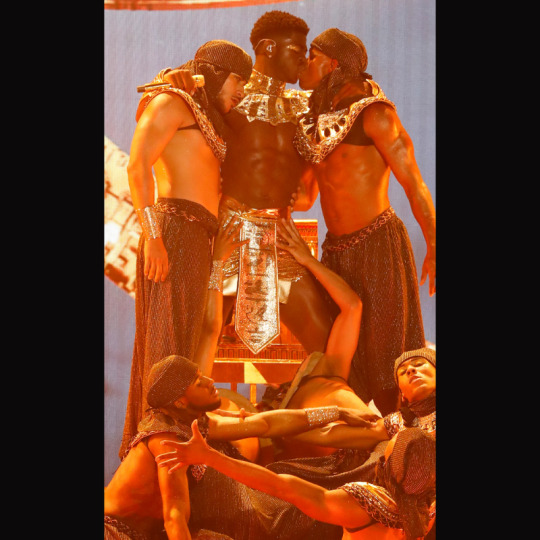
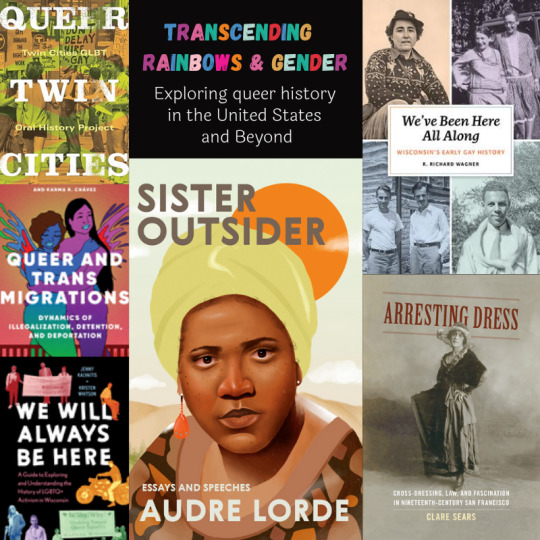


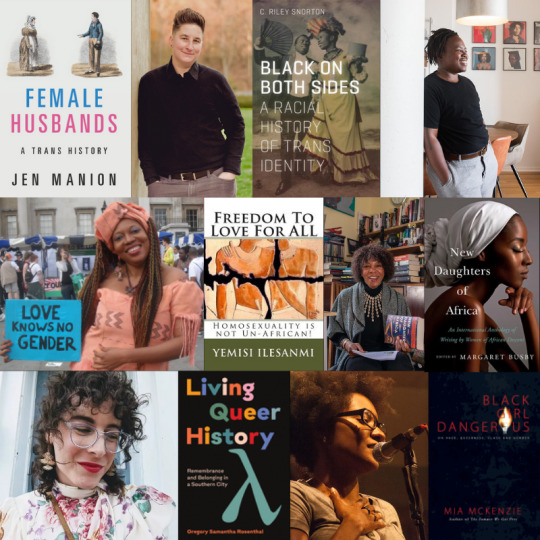
Lil Nas X is letting y'all know that queerness is not a "white people thing." 💁🏾♀️🌈
Queerness is ancestral || queer folks existed in pre-colonial spaces, struggled and resisted under colonialism, and are kicking down barriers in the 21st century.
Here are some must reads by scholars, poets, and activists who are sharing the histories, lived experiences, and ancestral-liberation work of those who came before and those blooming and yet to come~
Find their works listed below on my Neighborhood Historian bookshop.
Top Picks
Sister Outsider: Essays and Speeches - Audre Lorde (1984)
Freedom To Love For ALL: Homosexuality is not Un-African - Yemisi Ilesanmi (2013)
Black on Both Sides: A Racial History of Trans Identity - C Riley Snorton (2017)
On Earth We're Briefly Gorgeous - Ocean Vuong (2019)
Black Girl, Call Home - Jasmine Mans (2021)
The Transgender Issue: An Argument for Justice - Shon Faye (Pre-Order)
Queer History, Activism, and Liberation in the United States (by time period)
Female Husbands: A Trans History - Jen Manion (2020)
Arresting Dress: Cross-Dressing, Law, and Fascination in Nineteenth-Century San Francisco - Clare Sears (2014)
We've Been Here All Along: Wisconsin's Early Gay History - R. Richard Wagner (2019)
Welcome to Fairyland: Queer Miami Before 1940 - Julio Capó (2017)
Her Neighbor's Wife: A History of Lesbian Desire Within Marriage - Lauren Jae Gutterman (2019)
Queer Clout: Chicago and the Rise of Gay Politics - Timothy Stewart-Winter (2017)
The Deviant's War: The Homosexual vs. the United States of America - Erin Cervini (2021)
We Are Everywhere: Protest, Power, and Pride in the History of Queer Liberation - Matthew Riemer and Leighton Brown (2019)
Queer Twin Cities - collected by Twin Cities Glbt Oral History Project (2010)
Queerness Across Borders and Generations
We Have Always Been Here: A Queer Muslim Memoir - Samra Habib (2019)
Queer and Trans Migrations: Dynamics of Illegalization, Detention, and Deportation - (2020)
Tolerance and Risk: How U.S. Liberalism Racializes Muslims - Mitra Rastegar (Pre-Order)
Lived Experiences and Memories in Marginalized Spaces
Visibility Interrupted: Rural Queer Life and the Politics of Unbecoming - Carly Thomsen (2021)
Living Queer History: Remembrance and Belonging in a Southern City - Gregory Samantha Rosenthal (Pre-order)
Girl, Woman, Other: A Novel - Bernardine Evaristo (2019)
On Being Different: What It Means to Be a Homosexual - Merle Miller (1971)
Black Girl Dangerous on Race, Queerness, Class and Gender - Mia McKenzie (2014)
Steel Closets: Voices of Gay, Lesbian, and Transgender Steelworkers - Anne Balay (2016)
Rust Belt Burlesque: The Softer Side of a Heavy Metal Town - Erin O'Brien and Bob Perkoski (2019)
Study Resources
We Will Always Be Here: A Guide to Exploring and Understanding the History of LGBTQ+ Activism in Wisconsin - Jenny Kalvaitis and Kristen Whitson (2021)
New Daughters of Africa: An International Anthology of Writing by Women of African Descent - edited by Margaret Busby (2019)
Black Queer Studies: A Critical Anthology - E. Patrick Johnson (2005)
#black lives matter#black trans lives matter#let black women thrive#book recommendations#resources for you#antiracist resources#decolonize your mind#bookstagram#padawan historian#your friendly neighborhood historian#lil nas x#queer topics#pride month#compilation
3K notes
·
View notes
Photo
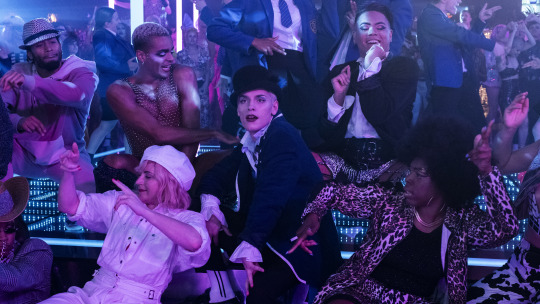
Wigging Out.
Choreographer and director Jonathan Butterell tells Gemma Gracewood about stepping behind the camera for Everybody’s Talking About Jamie, his love for Sheffield, and making sure queer history is kept alive. Richard E. Grant weighs in on tolerance and Thatcher.
Of 2021’s many conundrums, one for musical lovers is why the narratively problematic Dear Evan Hansen gets a TIFF premiere and theatrical release this month, while the joyously awaited Everybody’s Talking About Jamie went straight to Amazon Prime.
And yet, as the show’s lyrics go, life keeps you guessing, along came a blessing. There’s something about the film streaming onto young people’s home screens, with its moments of fourth-wall breaking where Jamie speaks straight to the viewer, that feels so important, given the content: a gay teen whose drag-queen destiny sits at odds with the less ambitious expectations of his working-class town.
Director and choreographer Jonathan Butterell, who also helmed the stage production (itself inspired by Jenny Popplewell’s 2011 BBC documentary, Jamie: Drag Queen at 16) agrees that the worldwide Amazon release is a very good silver lining. “I made the film for the cinema but, in 250 territories across the world, this is going to have a reach that—don’t get me wrong, cinema, cinema, cinema, collective experience, collective experience, collective experience—but it will get to people that it might not have got to before.
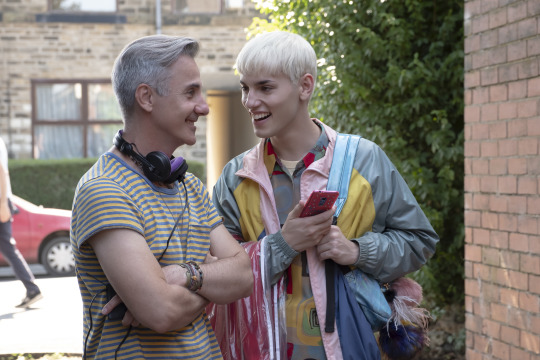
Jonathan Butterell on set with star Max Harwood, as Jamie.
“It feels as niche a story as you could possibly be. But also for me, I wanted it to feel like a universal story, that it didn’t matter where on any spectrum you found yourself, you could understand a young person wanting to take their place in the world freely, openly and safely.”
Everybody’s Talking About Jamie, with screenplay and lyrics by Tom MacRae and songs by Dan Gillespie Sells, sits neatly among a series of very specific feel-good British films about the working class experience, such as Billy Elliot, Kinky Boots and Pride. The film adds some historical weight to the story with a new song, ‘This Was Me’, which allows Jamie’s mentor, Hugo (played by Richard E. Grant), to take us into England’s recent past—the dark days of the discriminatory Section 28 laws, at a time when the HIV/AIDS epidemic was still ravaging the community.
Hugo’s drag persona Loco Chanelle (played in the flashback by the stage musical’s original Jamie—John McCrea from Cruella and God’s Own Country), sports a wig that looks suspiciously like the Iron Lady’s unmistakable head of hair. Grant confirms that was Hugo’s intention. “His heyday was in the 1980s, so as a ‘fuck you’ to Mrs Thatcher, what better than to be dressed up like that, at six-foot-eight, with a wig that could bring down the Taj Mahal!”
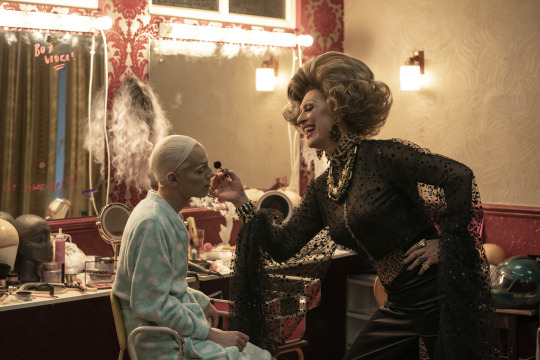
Richard E. Grant as Hugo, getting to work on Jamie’s contours.
In light of the current pandemic, and the fact that the 1967 legalization of homosexuality in Britain is only “an historical blink away”, Grant’s hope is for more tolerance in the world. “Maybe Covid gives people some sense of what that was like, but with Covid there’s not the prejudice against you, whereas AIDS, for the most part in my understanding, was [seen as] a ‘gay disease’, and there were many people across the globe who thought that this was, you know, whatever god they believe in, was their way of punishing something that they thought was unacceptable.
“The message of this movie is of inclusivity, diversity, and more than ever, tolerance. My god, we could do with a dose of that right now.”
Read on for our Q&A with Jonathan Butterell about the filmic influences behind Everybody’s Talking About Jamie.
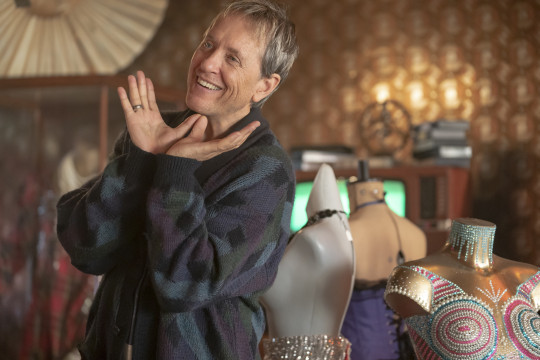
Hugo in a reverie, surrounded by his drag menagerie.
Can we talk about the new song, ‘This Was Me’, and the way you directed it in the film? It’s a show-stopper, with Richard E. Grant singing in that beautiful high register, and then moving into Holly Johnson’s singing, as you go back in time to show that deeply devastating and important history.
Jonathan Butterell: It felt inevitable, the shift, and necessary. Myself, Dan Gillespie Sells, the composer, and Tom MacRae, the screenwriter, we created this piece together, the three of us, and it’s a film by the three of us. We lived through that time, we went on those marches. Actually, in one of those marches [shown in flashback], Dan’s mum—actual mum—is in a wheelchair, by a young boy who was holding a plaque saying “my mum’s a lesbian and I love her”.
That is Dan with his mum back in the day, and it all speaks to our stories and it moves me, I can see it’s moving you. It moves me because I lived through that time, and it was a complex time for a young person. It was a time that you felt you had to be empowered in order to fight, and you felt very vulnerable because of the need to fight. And because of that disease, because HIV was prevalent and we lost people—we lost close people—it was a difficult time. I wanted to make sure that that story kept being told and was passed on to the next generation.
It’s so important isn’t it, to walk into the future facing backwards?
It still exists, that need to fight still exists. The conversation, yes, has moved on, has changed, but not for all people and not in all communities.
What would be your go-to movie musical song at a karaoke night?
My goodness. There’d be so many.
I mean, is it going to be a Cabaret, a Chicago showstopper, or something more Mary Poppins, something from Rent?
I think what I would go to, which is what I remember as a little boy, is Curly singing ‘Oh, What A Beautiful Mornin’. It’s such a kind of perfect, beautiful, simple song. That, and ‘The Lonely Goatherd’, because I just want to yodel. It would be epic. Trust me.
What is the best film featuring posing and why is it Paris Is Burning?
It’s always Paris Is Burning. Back in the day, I was obsessed with Paris Is Burning, I was obsessed with that world. In fact, at one moment I even met [director] Jennie Livingston in trying to make a theater piece inspired by that. I lived in New York for eleven years and I met Willi Ninja. I just adored everything about him, and he would tell me stories. And again, it was so removed from the boy from Sheffield, I mean so far. That New York ballroom scene was so removed from my world, but I got it. Those two boys at the top of the film, I just wanted to be one of those boys who just hung out outside the club.
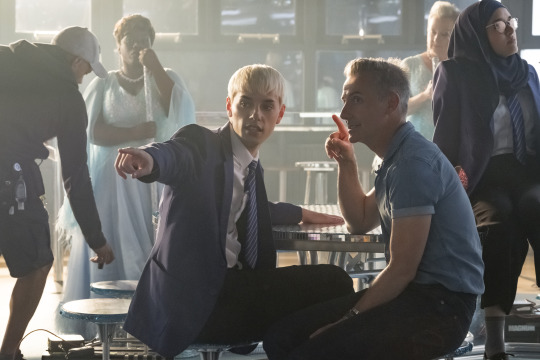
Harwood and Butterell on set, with Lauren Patel (right) as Jamie’s bestie Pritti Pasha.
What films did you and Tom and Dan look at to get a feeling for how to present the musical numbers?
Actually, a lot of pop videos, from present day to past. There’s an homage, in the black-and-white sequences, to a little ‘Vogue’ Madonna moment. Pop is very central to me in this story because pop is what a working-class kid from a working-class community will be listening to. That’s in his phone, that’s in his ears. Not that many young people listen to much radio at this moment in time, but that’s what will be on Margaret’s radio, that’s what’s coming into the kitchen. And that was central to the storytelling for me.
Bob Fosse also really influenced me, and particularly All That Jazz and where his flights of imagination take him. I felt that was so appropriate for Jamie, and again in a very, very different way, but I could see how Jamie’s imagination could spark something so fantastical that would lead him to dance, lead him to walk on the most amazing catwalk, lead into being in the most fabulous, fabulous nightclub with the most amazing creatures you’ve ever met in your life.
For me personally, the film that most inspired me was Ken Loach’s Kes, because that is my community. Both the world in which Jamie exists—Parsons Cross council estate, is my world, is my community—and the world of that young boy, finding his place in the world with his kestrel friend, I remember identifying with that boy so clearly. He was very different from me, very different. But I got him, and I felt like Ken Loach got me through him.
Ken Loach made a few films set in Sheffield, didn’t he? But also, Sheffield is a setting and an influence on The Full Monty, The History Boys, Funny Cow and that brilliant Pulp documentary. So Jamie feels like a natural successor.
It absolutely does. Sheffield’s where I grew up, it’s my hometown. Although I moved away from it, I always return. To have a chance to celebrate my community, and particularly that community in Parsons Cross council estate. If you’re in Sheffield and you’re in a taxi and you said, “Take me to Parsons Cross,” they’d say, “Well, I’ll drop you there, but I’m not staying.” Because again there’s a blinkered view of that community. And I know that community to be proud, glorious and beautiful.
And yes, that community, particularly through the ’80s, really suffered because some of that community would serve the steelworks and had three generations of unemployment, so they became disenfranchised because of that. But the community I grew up in, my Auntie Joan, who lived on that road, literally on that road, was a proud, working class, glorious woman who served chips at school.
Aside from Everybody’s Talking About Jamie, what would be the most important queer British cinematic story to you? (And how do you choose between My Beautiful Laundrette and God’s Own Country?!)
You can’t. My Beautiful Laundrette influenced me so much because, one, Daniel Day Lewis was extraordinary in that film, and two, because of the cross-cultural aspect of it. I went, “I know this world”, because again I grew up in that world. And it affirmed something in me, which is the power and the radicalness of who I could be and what I could be.
With God’s Own Country, when I saw that film—and that was Francis’ first film, which I thought was extraordinary for a first-time filmmaker—I knew he knew that world from the inside, from the absolute inside. And I know what that rural community was like. I read that script, because we share agents, and I was blown away by it—again, because of the two cultures coming together.

Jamie Campbell, the film’s real-life inspiration, with screen-Jamie Max Harwood.
Richard E. Grant’s character, Hugo, is such a pivotal mentor for Jamie. What did you need to hear from a mentor when you were sixteen?
Don’t let yourself hold yourself back, because I think it was me who put some limitations on myself. And of course I came from a working-class community. I was a queer kid in a tough British comprehensive school. And did I experience tough times? Yes I did. And did I deal with those tough times? Yes I did. But the song that speaks to me mostly in this is ‘Wall in my Head’, in which Jamie takes some responsibility for the continuation of those thoughts, continuations of the sorts of shame, and that’s a sophisticated thing for a sixteen-year-old boy to tackle.
I also was lucky enough to have a mother like Margaret—and a dad like Margaret as well, just to be clear! And I remember my mum, at seventeen when I left home, just leaving a little note on my bed. It was quite a long letter. She said, Jonathan, you’ve probably chosen to walk a rocky path, but don’t stray from it, don’t steer away from it. That’s the path you've chosen, there may be rock-throwers along the way, but you’ll find your way through it. That stayed with me and I think that’s what resonates with me. And when I saw that documentary, Jamie: Drag Queen at 16, I felt that that sparked the need for me to tell that story.
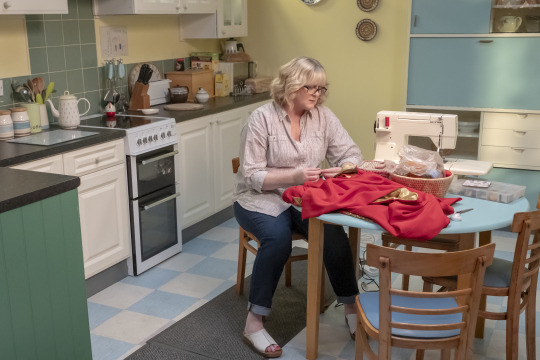
Sarah Lancashire as Jamie’s mum, Margaret New.
We need more mums and dads like Margaret, don’t we?
We do, we do. And the wonderful thing is, Margaret Campbell will say it and I think Margaret New in the film will say it: she’s not a Saint, she’s an ordinary mum. And she has to play catch up and she doesn’t understand in many ways, and she gets things wrong and she overprotects. But she comes from one place and that is a mum’s love of her child and wanting them to take their place safely in the world and to be fully and totally themselves.
Related content
Eternal Alien’s list of films Made in Sheffield
Letterboxd’s Camp Showdown
Persephon’s list of films recommended by drag queens
Passion’s list of films mentioned by Jaymes Mansfield in her Drag Herstory YouTube series
Follow Gemma on Letterboxd
‘Everybody’s Talking About Jamie’ is streaming now on Amazon Prime Video.
#everybody's talking about jamie#max harwood#john mccrae#richard e. grant#sharon horgan#jonathan butterell#musicals#drag queen#queer film#lgbtqia cinema#british cinema
18 notes
·
View notes
Text

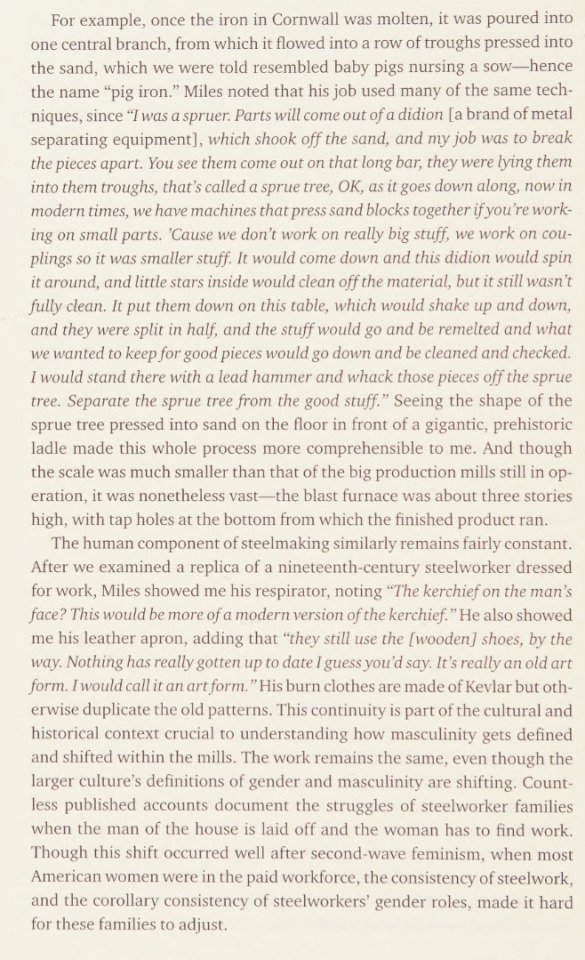
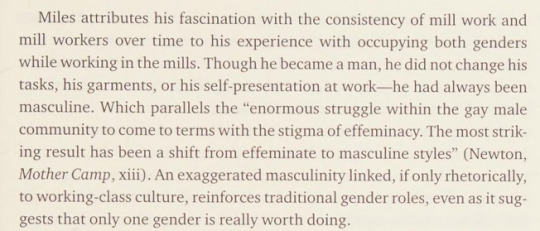
Steel closets : voices of gay, lesbian, and transgender steelworker by Anne Belay, available on the Internet Archive
Transcript:
Miles began working in a steel mill in 1999 as an out lesbian, but he quit about eight years later because of repeated shoulder injuries and general exhaustion. He says it's not really accurate to say that he transitioned while working at the mill, since "we never really have a transition. We'll always be transgendered because our past experiences and history go along with us. So I'll always consider myself transitioning." I met Miles at the Cornwall Iron Furnace just outside of Philadelphia. It's a National Historic Landmark, pre- serving a nineteenth-century ironmaking complex and documenting the ironmaking process, as well as its effect on the area around the furnace and the workers' lives. Miles had suggested this meeting place, noting that he had always wanted to see the exhibits. He was curious about the history of the steelmaking process, and tickled by seeing his huge, powerful, mascu- line job echoed within this seemingly fragile incarnation made of bricks, and described for us by local elderly ladies.
For example, once the iron in Cornwall was molten, it was poured into one central branch, from which it flowed into a row of troughs pressed into the sand, which we were told resembled baby pigs nursing a sow-hence the name "pig iron." Miles noted that his job used many of the same tech- niques, since "I was a spruer. Parts will come out of a didion [a brand of metal separating equipment], which shook off the sand, and my job was to break the pieces apart. You see them come out on that long bar, they were lying them into them troughs, that's called a sprue tree, OK, as it goes down along, now in modern times, we have machines that press sand blocks together if you're work- ing on small parts. 'Cause we don't work on really big stuff, we work on cou- plings so it was smaller stuff. It would come down and this didion would spin it around, and little stars inside would clean off the material, but it still wasn't fully clean. It put them down on this table, which would shake up and down, and they were split in half, and the stuff would go and be remelted and what we wanted to keep for good pieces would go down and be cleaned and checked. I would stand there with a lead hammer and whack those pieces off the sprue tree. Separate the sprue tree from the good stuff." Seeing the shape of the sprue tree pressed into sand on the floor in front of a gigantic, prehistoric ladle made this whole process more comprehensible to me. And though the scale was much smaller than that of the big production mills still in op- eration, it was nonetheless vast-the blast furnace was about three stories high, with tap holes at the bottom from which the finished product ran.
The human component of steelmaking similarly remains fairly constant. After we examined a replica of a nineteenth-century steelworker dressed for work, Miles showed me his respirator, noting "The kerchief on the man's face? This would be more of a modern version of the kerchief." He also showed me his leather apron, adding that "they still use the [wooden] shoes, by the way. Nothing has really gotten up to date I guess you'd say. It's really an old art form. I would call it an art form." His burn clothes are made of Kevlar but oth- erwise duplicate the old patterns. This continuity is part of the cultural and historical context crucial to understanding how masculinity gets defined and shifted within the mills. The work remains the same, even though the larger culture's definitions of gender and masculinity are shifting. Count- less published accounts document the struggles of steelworker families when the man of the house is laid off and the woman has to find work. Though this shift occurred well after second-wave feminism, when most American women were in the paid workforce, the consistency of steelwork, and the corollary consistency of steelworkers' gender roles, made it hard for these families to adjust.
Miles attributes his fascination with the consistency of mill work and mill workers over time to his experience with occupying both genders while working in the mills. Though he became a man, he did not change his tasks, his garments, or his self-presentation at work-he had always been masculine. Which parallels the "enormous struggle within the gay male community to come to terms with the stigma of effeminacy. The most strik- ing result has been a shift from effeminate to masculine styles" (Newton, Mother Camp, xiii). An exaggerated masculinity linked, if only rhetorically, to working-class culture, reinforces traditional gender roles, even as it sug- gests that only one gender is really worth doing.
20 notes
·
View notes
Text

So I went to this^ the Stranger Things Drive-Into Experience recently, and it was..... totally awesome!!! (in my opinion, but I’m very easily entertained though so🤷♀️) Here’s my run-through/review for anyone that can’t go to the dang thing🤗
But I will be spoiling some things from the experience/possible hints they gave about s4, so if you’re planning to go before it closes out or just not into spoilers *scroll awaayyyyy my friend*
~Long Post Alert~
********************************************
Alrighty then! So, when you scan you’re ticket they tune you in to a radio station that is broadcasting the show. And first thing you see after you get ushered into the numerous lanes is the CAMARO😱

Complete with tire smoke and conveniently placed in front of the Scoops Ahoy sign🤔😏 But this is supposed to be like you’re driving up to the mall with all the shit going on at the end of s3
Except when you pull up to their actual “mall” they have this (kinda goofy) pre-show deal hosted by a Mr. Clarke lookalike and some very enthusiastic Jazzercise people. And since you’re supposed to be at Starcourt, they have this little menu of themed concessions (mostly Scoops stuff🍦) that you can have delivered to the car.
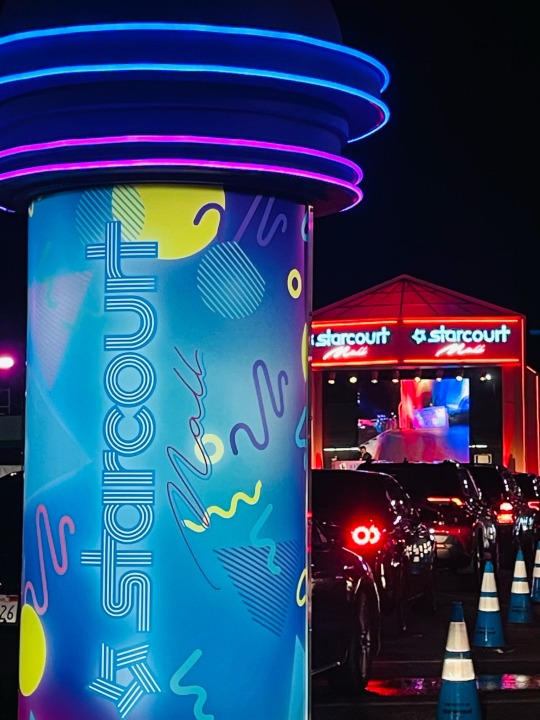
Anyway, the show is cute- they’ve got Will, Mike, Lucas, El and Max talking to Mr. Clarke and doing trivia for the audience. Not to mention that the kids come out and interact with the cars. Max waved awkwardly at us and it was great lol
THEN when you get the go ahead, you tune into another radio station with Murray telling you what’s up. Basically, Russians have infiltrated Hawkins and Starcourt Mall, opened a gate and the gang (basically just Scoops Troop) is trying to fix things.
You drive up through a parking garage, and the first level you stop at is the Russian lab.🚨
Then Steve and Robin come out and try to shut down the big machine or whatever and have to hide from the Russian soldiers. Dustin drives a little cart around in circles yelling wildly, a demogorgon comes out and starts terrorising cars.....
I actually didn’t pay that much attention cause a Russian guard dude was teasing me for having a snack while I watched the show, tried to get the demogorgon to come scare me specifically, and it ended up chasing him away😂
And STEVE HARRINGTON FLIRTED WITH ME!!😫😭😍 it was great, before they closed out this part of the show his voiceover did the “ahoy ladies” bit and the guy playing Steve was all winking at me and did the ‘call me’🤙 thing~ I was honestly distracted the rest of the show cause all I could think was I FLIRTED WITH STEVE HARRINGTON😱💖🤯
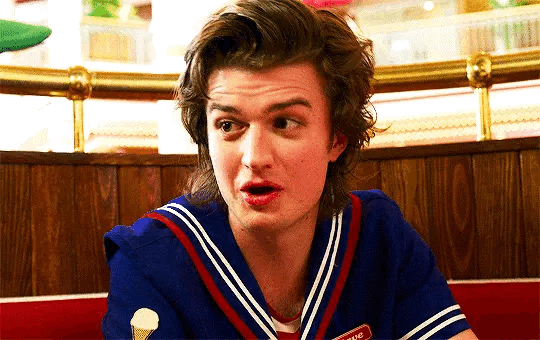
NEXT you drive into the upside dooowwwnn *spooky* they’ve got the black vines, blue lighting, and fake snow acting as those little white floaties😯
They direct you to pull up in front of a big screen where you watch a montage of Will being lost in the upside down and possesed by the mind flayer (a recap of the upsetting parts of seasons 1 & 2)
Then everything turns RED, they start playing the haunting synth theme of the flayed in season 3 and there’s another shorter montage of Billy getting flayed and people melting into the flesh monster (I think? again, I’m already distracted by what happened with Steve and I was mostly trying to focus on every little deta about Billy at this point lol)

And for the finale, you pull up on the roof of this parking garage which is decked out to look like the inside of Brimborn Steelworks😳
Since we were the last car in the whole fucking crowd we missed the first half of Billy’s monologue😒 but it was when he was talking to El, the “we built this for you” speech which is just extra haunting when it’s blaring through your car speakers...
Then Eleven rises through the air and spins down, like she was falling through the void⬛️ (it was awesome) and you watch another montage all about El’s story: her captivity at the lab and with Brenner, escaping and meeting the boys, everything with the gate- it’s really just a recap of the show but it’s cool cause they act a lot of it out in front of the screens.
There’s this cute bit where there’s several different sets of actors playing Hopper & El, and they act out all the things they did while cleaning up and then living in the cabin~🧹🕺👻
Then Billy comes back all fully possesed and with a vengeance, and here’s where I freaked a little, it looks like they have a battle of powers !!!!!!! Like, Billy has his hand outstretched towards El and she gets pushed down to the ground by an unseen force, until she gathers her strength and fights back.
I was distracted by Billy having telekinesis there for a minute so the next thing I knew, he was floating up in the air and we had to watch him die😞 and Max came out sobbing, and there was hugging and scoops troop came out to comfort the kids- and I think Billy just disappeared(? which, rude)
Then Dustin and Suzie performed never ending story ah aah ahh ah aah ahh ah aah aaaaahhh✨😐
And the cars start to exit, but there was this video playing that looked like security camera footage of the “LYNX mall delivery guys” aka Russians loading an unconscious Hopper into a van in the mall parking lot🚐 😲
Also worth noting that the exit song was Enola Gay by Orchestral Manouvers in the Dark, and the VIBE of that song just fit stranger things so well ohmygod I’m still floored it was so good🎶
On your way out you go buy merch and it gets delivered to your car, I got an authentic scoops hat which is honestly super comfortable🤓⚓️ and then you can (kinda anticlimactically) take a picture of the stranger things logo (which we did and got yelled at for taking too long trying to get our lopsided Polaroid oops😬📸)
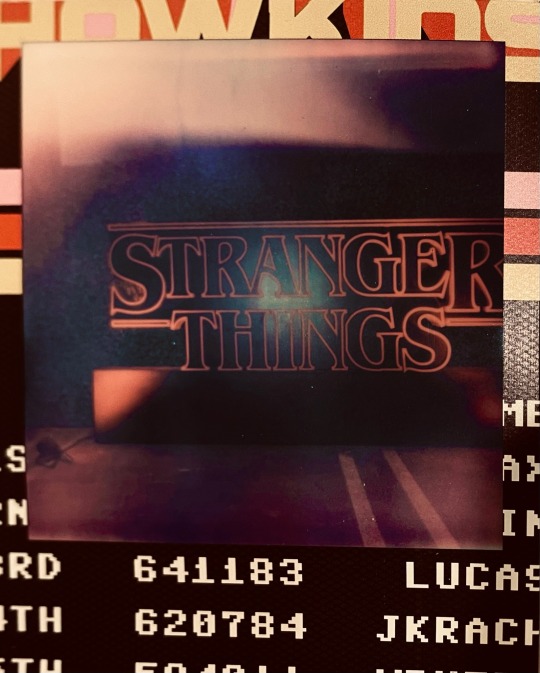
And that was my experience👍 If anyone else went and has points/details I missed PLEASE share cause ya know...Steve ‘The Hair’ Harrington fried my brain, so 😅
#stranger things#stranger things drive into experience#st spoilers#st4 spoilers#steve harrington#billy hargrove#chief hopper#sorry that was so long y’all#it was just a really amazing time for me lol#also worth mentioning for my good harringrove people that Steve flirted with me while I was wearing my Billy shirt#so that was fun#I really was thinking ‘ohmygod so this is what Billy feels like’😂😂😂#AND YO billys *powers*?! they may have just been the mind flayer but whew it was intense#and we all knew hoppers alive but yes he was collected by Russians straight from the mall#lets get season 4 now right?#😬#alright I’ll see my delusional ass out now BYEEEE
46 notes
·
View notes